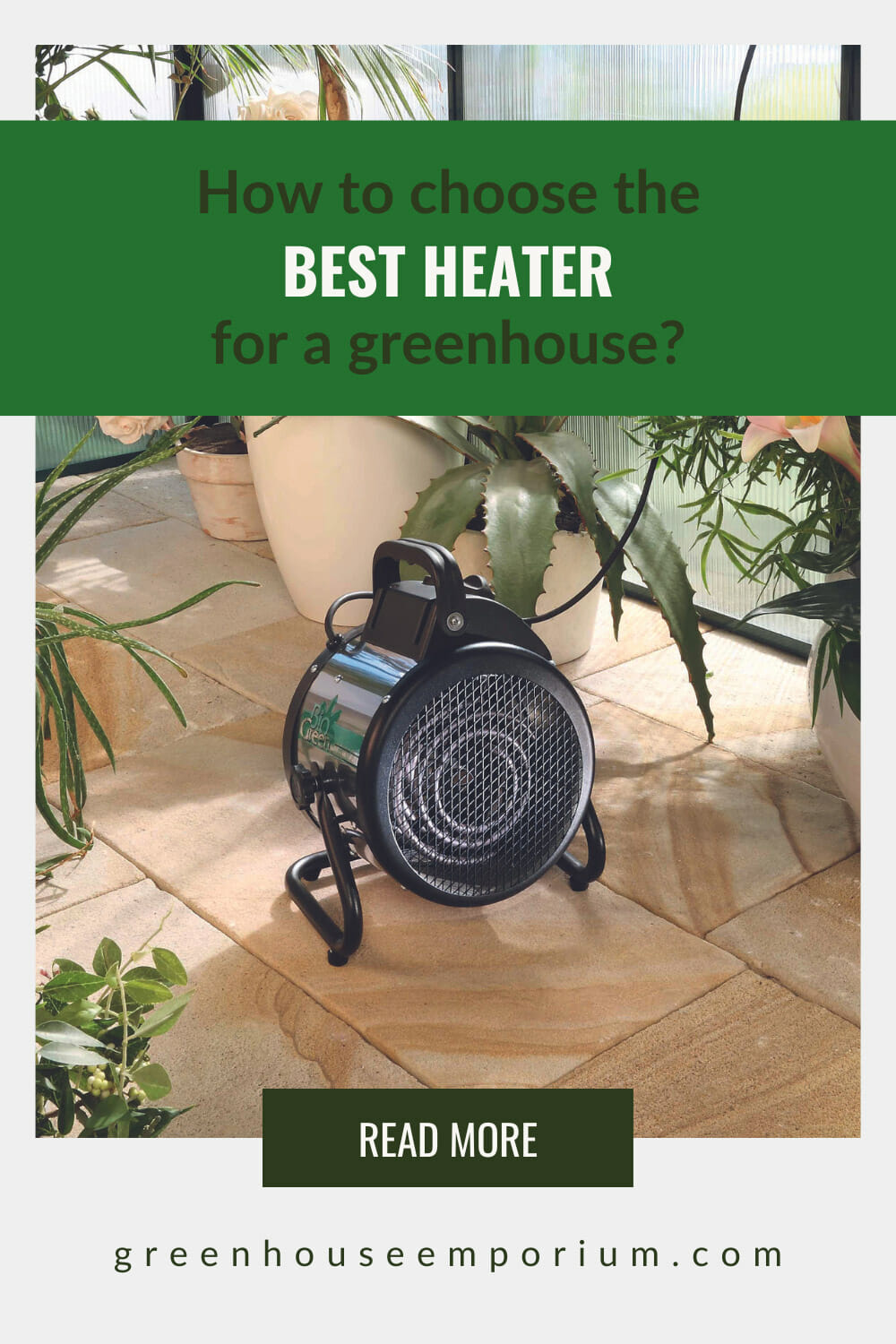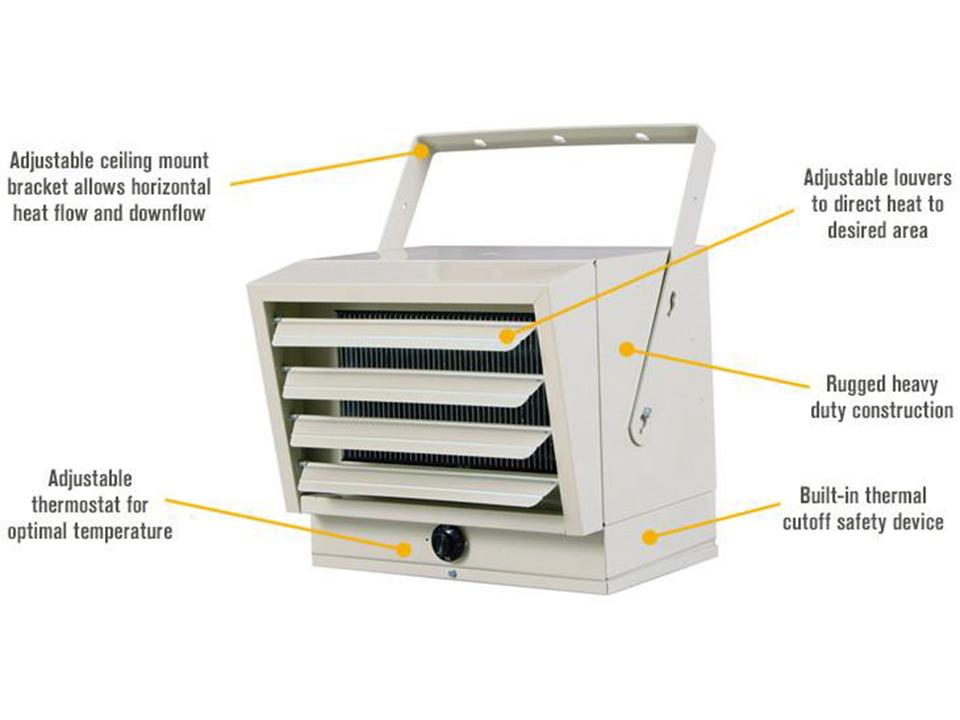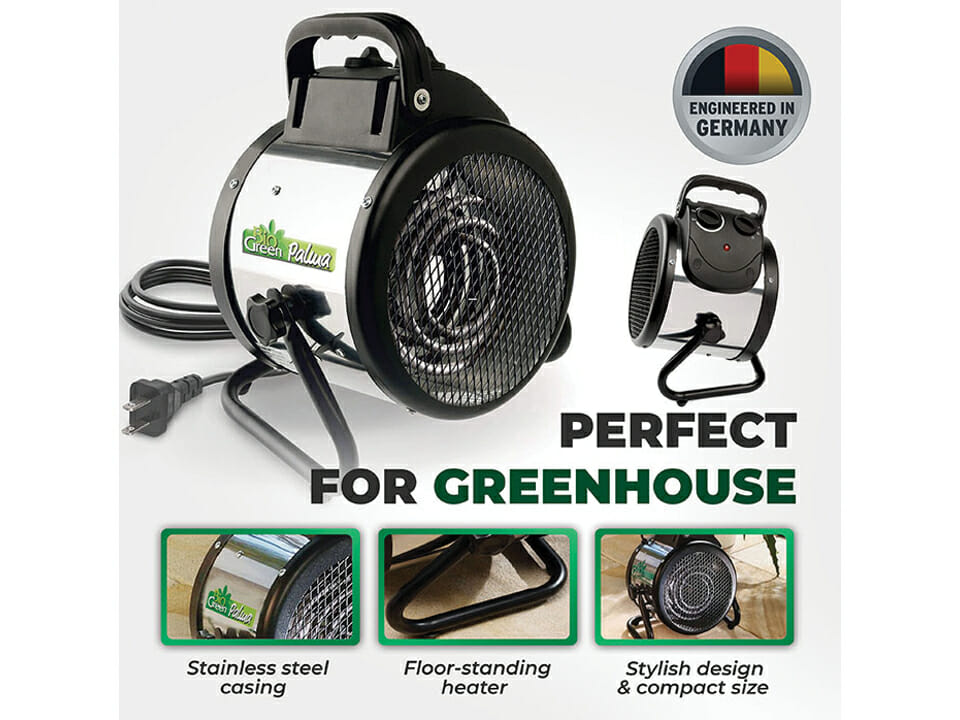A greenhouse is an invaluable thing to have for your tender plants during the winter. The best time to prepare your greenhouse for the coming winter months is to install a greenhouse heating system during fall. Heating a greenhouse is imperative when you want to maximize the potential of your plants during the cold winter season. We will show you the best greenhouse heaters in this article so that you can grow your favorite plants year-round!
You might be thinking that installing a heater in your greenhouse could be expensive. On the contrary, choosing the right heating design and equipment is affordable. For growers, the right heating equipment quickly gives them an ROI.
It goes without saying that adding heating to the design of the greenhouse is smart. However, an existing greenhouse can still be refurbished with a heater that does not have to rob the bank. As mentioned, the right heating product goes a long way in providing a comfortable greenhouse environment for you and your plants during winter.

How to pick the best greenhouse heater for the cold season?
There are a few factors that play a role in deciding for the right greenhouse heating system:
- What size is your greenhouse?
- How cold does it get in your location?
- What resource is the cheapest/most affordable option in your area?
- How well is your greenhouse insulated?
- How many plants do you want to grow?
- What type of plants are you going to grow?
Different plants need different temperatures to survive. Some love the warm weather and some are cool-weather crops. So, deciding on the heater has a lot to do with how you want to use your greenhouse. Plants actually create heat as well. Is your greenhouse going to be filled with plants or are you going to utilize only a fraction of the growing space?
With this being said, you have to think about how you are going to manage your greenhouse in winter. Otherwise, you cannot make the right choice for heating your greenhouse.
Let’s say, you are growing only hardy plants and you are using most of your greenhouse. Then either a DIY heating system (thermal mass) or a small space heater may be sufficient. If you have a larger greenhouse, you are not fully using it during the cold season and the temperatures get very rough in your area, you might need a greenhouse heater that can keep up with these conditions.
The size of your greenhouse also plays an important role in choosing the best type of heater. Make sure that the greenhouse is properly insulated so that the heat won’t escape.
You don’t necessarily need a heater if:
- Insulation is top-notch
- Mostly (cold-)hardy plants (no cold-sensitive plants) and you’re using your space well
- Used some DIY heating ideas (e.g. thermal mass, heat-absorbing rocks, greenhouse installed under frost line)

Which type of greenhouse heater should you pick?
The most common heater types are electric and gas. Most gardeners prefer gas heaters because they are affordable, especially in their local area. It uses natural or bottled gas. Gas heaters have the same effects as electric heaters. You simply need to install sufficient ventilation in your greenhouse because it may emit a significant amount of fumes. Confined fumes can be bad for you and your plants’ health.
The electric heater is so popular because of its efficiency in keeping warmth at a consistent level. It does not release any dangerous fumes. This is best for those greenhouses with insufficient ventilation. It might be best, but it is also the most expensive of the three.
Paraffin is the cheapest manual heater that anyone can buy from a local market. The fuel used is also affordable although it is a bit hard to find these days. It also gives off carbon dioxide which is needed by your plants.

How many BTUs do you need?
Ok, so this is a tricky question because – again – this depends on the greenhouse size (including height), insulation and greenhouse usage.
Theoretically speaking, 10,000 BTU is supposed to cover 400 – 450 sq.ft and 20,000 BTU around 1,000 sq.ft. However, this is for houses with insulated walls. A greenhouse does not have that much insulation. The R- or K-Value of your greenhouse model will give you an idea of how well insulated it is (not every model mentions this in the description). If you want to read more about greenhouse insulation, check out this article!
Then you also have to keep in mind the lowest temperatures in winter and what climate you want to create in your greenhouse.
Let us give you the extreme: Our biggest greenhouse is 16ft x 30ft and comes with a 30,000 BTU commercial gas heater. It is well insulated but not as good as the RIGA XL greenhouses. However, it’s enough to heat the space up in winter. This example may give you an idea of what you need for your situation.
If you want to get a better idea, you can utilize our greenhouse heater calculator. It will give you a closer estimate of the BTUs needed for your greenhouse and climate.
Electric greenhouse heaters
There are several upsides to electric heaters, foremost of which is to provide a steady temperature to your greenhouse. They come in different types. Tubular electric greenhouse heaters use a heating element to distribute warmth to the entire area. The lower electric consumption by omitting the need for fans. Fan-assisted models have a fan that radiates heat to specified areas
Pros:
- Effortless to use
- Electricity is readily available (for most people)
- Doesn’t need to be refilled
- Thermostat for easy control over temperature (no overheating or freezing)
- Provide a tightly controlled temperature to a specific area
- No toxic fumes
Cons:
- Heat may not be distributed evenly in some cases (some plants may get too much heat and others may freeze)
- Setting up electrical wires (if not there yet)
Top electric heaters for your greenhouse

For medium to large greenhouses: RSI Greenhouse Heating System
- 17,000 BTU
- Includes two heat settings
- Frost watch function is one of its best features
- Guarantees the right temperature with the built-in thermostat feature
- Switches off if overheating
- Doesn’t take up surface space: Easily hangs from rafters or ceiling
- Includes installation hardware and mounting bracket
For small to large greenhouses: AirNmore Infrared Space Heater
- 1500W
- Uses Copper PTC as the heating element
- Touch safe: Shell doesn’t heat up
- Tip-Over Sensor
- Two heat settings (1000W and 1500W)
- Fast heating
- On castors
- Up to approx. 800 sq.ft. (if insulated well)
- Heavy-duty particle filter

For small to medium greenhouses: BioGreen Palma Greenhouse Heater with Adjustable Thermostat
- Up to 120 sq.ft.
- 1500W
- Fast heating
- Adjustable, built-in bimetal thermostat with 9.1ft sensor range
- Quiet and easy to use
- Splash waterproof, slip-resistant rubber feet
- Safe for use in damp areas
Gas greenhouse heaters
Using gas to heat your greenhouse can be practical because it doesn’t require a power source. So, you don’t need to lay a cable. The problem with using gas, propane, and butane are the toxic fumes it emits. However, the requirement of high temperatures can be quickly accessed because of their built-in thermostat control.
Pros:
- Effortless to use
- A thermostat easily controls the temperature of the greenhouse
- High temperatures are easily accessed
- No power connection needed
- The traditional way of heating
Cons:
- Condensation problems are expected
- The fumes emitted may be toxic
- Needs a spare cylinder on hand at all times
- Needs refills of gas bottle
For medium to large greenhouses: Mr. Heater Corporation
- 20,000 BTU
- Up to 500 sq. ft.
- Blue flame
- With thermostat
- Battery-powered electronic ignition
- Automatic low oxygen shut-off system (ODS)
- Can stand on legs or be mounted on the wall
For medium to large greenhouses: Dyna-Glo 18,000 BTU Cabinet Heater
- Heats up to 450 sq. ft.
- 8,000-18,000 BTU
- Heats up to 64 hours using a 20 lb. propane tank
- Oxygen depletion sensor
- Tip-over protection
- Portable: Locking castors
Small greenhouses: Dyna-Glo Natural Gas
- 5,000-10,000 BTU
- Propane only
- Blue flame convection technology
- Heats up to up to 300 sq. ft.
- Customizable heat settings
Solar-powered greenhouse heaters
Greenhouse heating can cost a lot of energy consumption with the use of pumps and devices as well as maintaining the right temperature. Solar panels seem to hold the correct answer for serious gardeners who want to keep optimum plant growth and development. The use of solar panels to maintain a steady temperature throughout the year makes both plants and environment healthy and happy.
While any type of solar panels can be used for your greenhouse, the more efficient ones are the monocrystalline solar cells and the polycrystalline solar cells.
Polycrystalline solar cells
Pros:
- Silicon waste is avoided
- Effects on efficiency are not negatively affected by hotter temperatures
- More affordable option than the monocrystalline cells
Cons:
- The low purity levels of silicon do not make them an efficient solar panel option
- They are less space-efficient because of their lower output rates. Installing them means more roof space
Monocrystalline solar cells
Pros:
- High-efficiency rate of 15-20% that requires less space
- The usual warranty is for 25 years because manufacturers believe in the long lifespan of the solar cells
- Works efficiently even on cloudy days because they have always shown peak performance even on low sunlight levels
Cons:
- Very expensive, in fact, the most costly solar cell available on the market
- A rise in temperature can sometimes affect the levels of their performance
- Manufacturing them leads to a lot of silicon waste

























28 comments
Have high tunnel FramTech green house 24′ x 26′ x 13H. We do not have access to electricity. Can you recommend a battery operated heater? And how many for temperatures from 17 degrees at worst but mostly in 30 -50 degrees in El Paso, TX.
Hi Judy! I don’t have any suggestions for a battery operated heater. A propane heater would be a great choice for you as it does not require electricity. You will want to look for a heater that will produce about 30,000 BTUs for the square footage of your greenhouse. Good luck with your greenhouse growing!
Is it possible to keep a polytunnel greenhouse warm I have a 10x20x9 I also live in northern Michigan where our winters get well below -20 at night sometimes. Electricity isn’t a problem. I would like to do my gardening through out the whole year.
Hi Christine! One way to keep a greenhouse warm is to retain heat from sunlight as long as possible. You can do this by lining rocks along the inside of the polytunnel to absorb daytime heat. They will take longer to cool than the air and help slow the temperature decline later in the day. You also mentioned electricity is available. You may want to consider a small space heater safely placed away from the walls of the polytunnel. If the entire polytunnel is not in use, you can also section off the empty areas to lessen the amount of space that requires heat. Hope this helps! Good luck with your greenhouse gardening.
We live in growing zone 6. In the winter we often see lows in Dec-Feb in the teens and highs in the 40s. We have sun most days. Will solar powered heating be able to keep a greenhouse warm? Do you have a recommendation of a heater for a greenhouse than runs on solar?
Hi Daniella, Unfortunately we do not offer any Solar heater options. We will attempt to cover this topic in our up coming articles.